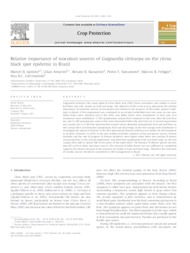Relative importance of inoculum sources of Guignardia citricarpa on the citrus black spot epidemic in Brazil.
Relative importance of inoculum sources of Guignardia citricarpa on the citrus black spot epidemic in Brazil.
Autoria: SPÓSITO, M. B.; AMORIM, L.; BASSANEZI, R. B.; YAMAMOTO, P.; FELIPPE, M. R.; CZERMAINSKI, A. B. C.
Resumo: Guignardia citricarpa, the causal agent of citrus black spot (CBS), forms ascospores and conidia in citrus leaf litter and only conidia on fruit and twigs. The objective of this work was to determine the relative importance of inoculum sources of ascospores and conidia in the progress of CBS under natural conditions in Brazil. A first experiment was conducted in an orchard subdivided into two areas. In one area, fallen leaves were removed and in the other area fallen leaves were maintained. In each area, two treatments were established: 1) CBS symptomatic mature fruit remained on the trees after the new fruit set, and 2) CBS symptomatic mature fruit were harvested before the new fruit set. A second experiment was carried out in a CBS-free experimental orchard where detached symptomatic fruit and leaf litter on the orchard floor and detached symptomatic fruit and dead twigs on the tree canopy were distributed to investigate the spread of disease. In the first experiment disease incidence was similar for all treatments in all years. However, in 2003, in the area without leaf litter (absence of the ascospores source), disease intensity and the rate of progress of disease incidence were higher when there was overlap of mature and young fruit. In the second experiment, only detached symptomatic fruit and dead twigs on the tree canopy were able to spread CBS in two years of the experiment. The distance of disease spread was less than 80 cm from these inoculum sources. The removal of fallen leaves was not sufficient to completely suppress the disease because of the presence of conidia in fruit and dead twigs. Therefore the reduction of conidia sources should be considered in CBS management in Brazil.
Ano de publicação: 2011
Tipo de publicação: Artigo de periódico
Unidade: Embrapa Uva e Vinho
Palavras-chave: Brasil, Doença de planta, Epidemiologia, Fruta cítrica, Fruticultura, Guignardia citricarpa, Manejo
Observações
1 - Por padrão são exibidas publicações dos últimos 20 anos. Para encontrar publicações mais antigas, configure o filtro ano de publicação, colocando o ano a partir do qual você deseja encontrar publicações. O filtro está na coluna da esquerda na busca acima.
2 - Para ler algumas publicações da Embrapa (apenas as que estão em formato ePub), é necessário ter, no celular ou computador, um desses softwares gratuitos. Sistemas Android: Google Play Livros; IOS: iBooks; Windows e Linux: software Calibre.
Acesse outras publicações
Acesse a Base de Dados da Pesquisa Agropecuária (BDPA) para consultar o acervo completo das bibliotecas da Embrapa.

